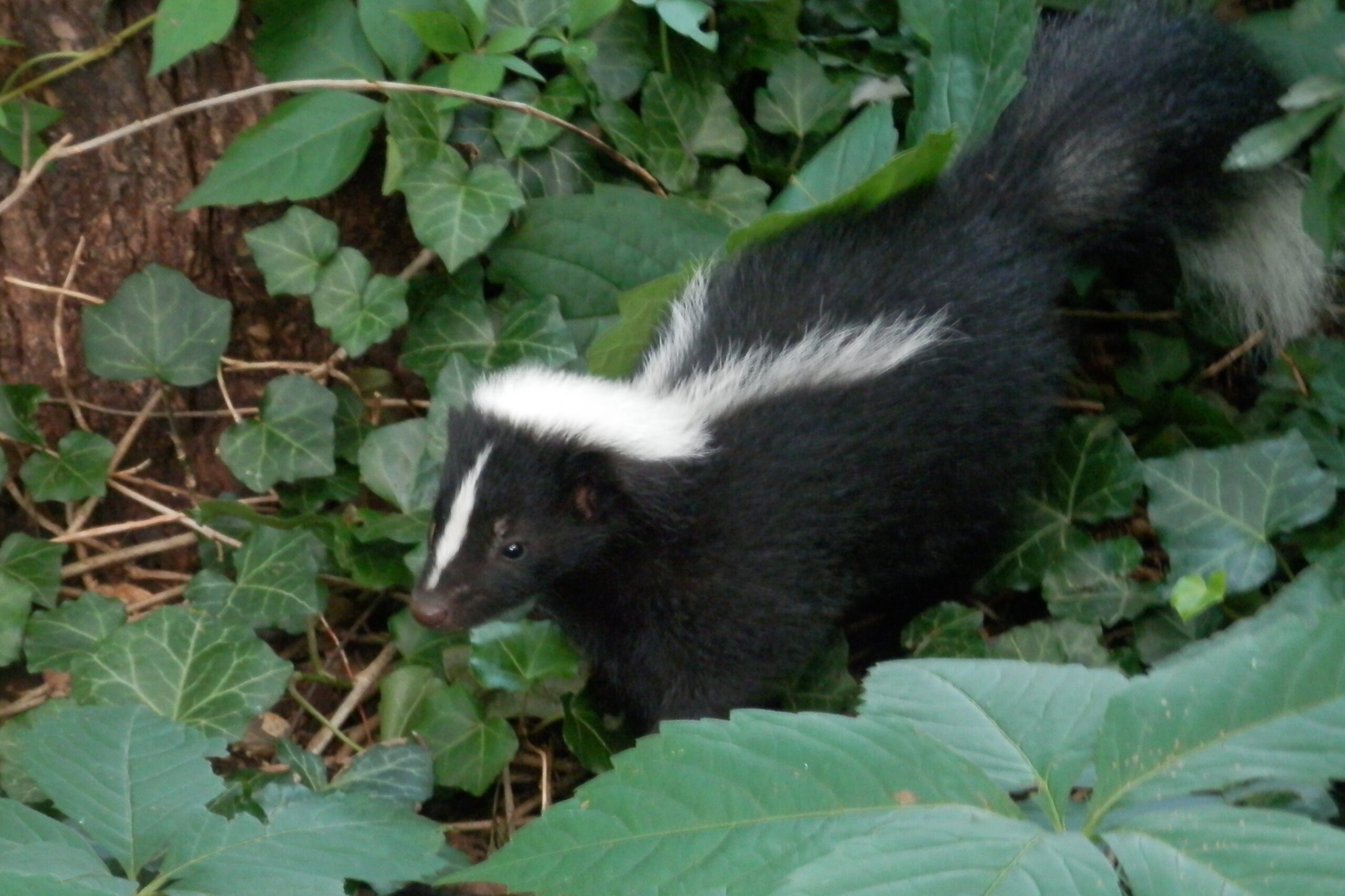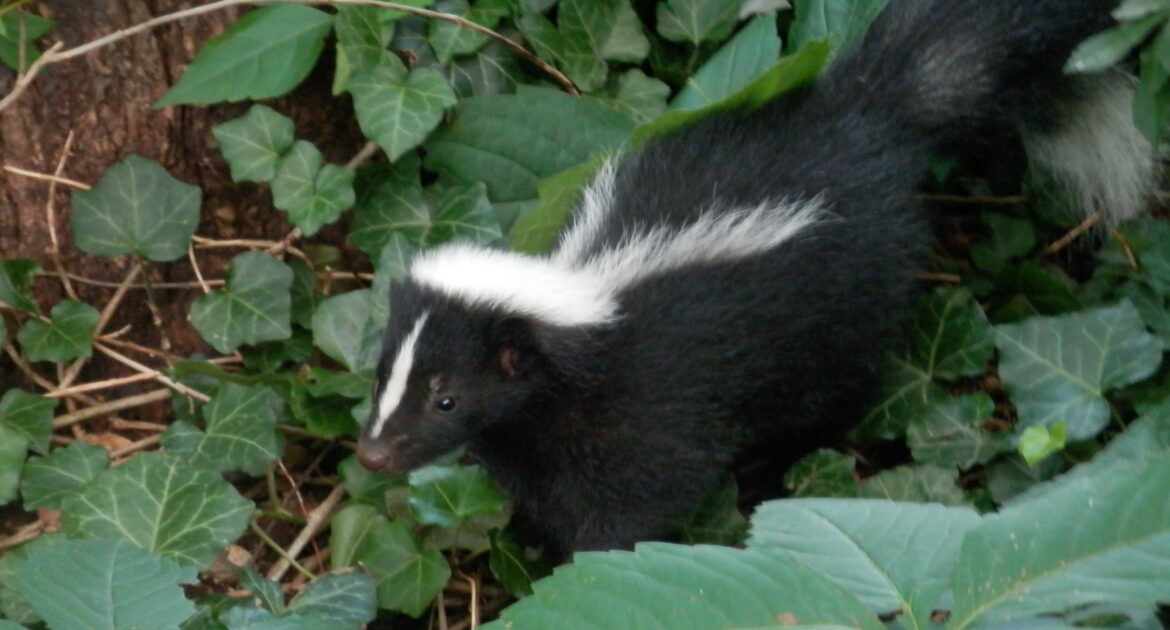Skunks are one of nature’s most recognizable and misunderstood creatures. Their distinctive black and white coloration serves as a warning to potential threats, but there’s much more to these remarkable animals than their infamous defense mechanism. Skunk survival traits have evolved over thousands of years, creating a highly adaptable creature that thrives even in human-populated areas like Oakville. As wildlife removal experts, we at Skedaddle Humane Wildlife Control have developed a deep appreciation for these resilient animals while helping homeowners maintain a safe distance from them.
While most people immediately think of the spray when skunks come to mind, these creatures possess an impressive collection of survival adaptations that extend beyond their chemical defense. From specialized digging abilities to remarkable sensory skills, skunks are perfectly equipped to survive in various environments.
Let’s explore the captivating world of skunk biology and behaviour to better understand why they are so successful at surviving—and why they sometimes choose to make their homes in our yards, under structures, and near our properties.
The Science Behind the Spray: Skunk Defense Mechanisms
Perhaps the most famous of all skunk survival traits is their powerful defense spray. This remarkable chemical weapon is produced in specialized glands located near the base of the tail. When threatened, skunks can accurately spray this noxious substance up to 10-15 feet away, creating an immediate deterrent for potential predators.
Chemical Composition: The spray contains sulfur-based compounds called thiols (specifically, butyl mercaptan), which create the unmistakable odour. These chemicals can cause temporary blindness, nausea, and disorientation in threats—giving the skunk plenty of time to escape.
Precision Targeting: Contrary to popular belief, skunks don’t just spray randomly. They can aim with remarkable accuracy, directing the stream toward a threat’s face for maximum effect. Their ability to control the intensity of the spray—from a light mist to a concentrated stream—demonstrates the sophistication of this defense mechanism.
Conservation Strategy: A skunk produces a limited amount of spray and requires about 10 days to fully replenish its supply after depleting it. This explains why skunks display a series of warning behaviours before resorting to spraying:
- Stamping front feet to create vibrations that warn potential threats
- Raising their tail as a visual warning
- Making short forward charging movements to intimidate
- Turning their hindquarters toward the threat, preparing to spray
Understanding these warning signs is crucial for homeowners in Oakville who might encounter skunks on their property. At Skedaddle, we train our technicians to recognize these behaviours during removal operations to ensure we can safely manage skunks without triggering their defensive spray.
Beyond the Spray: Physical Adaptations for Survival
While their chemical defense gets most of the attention, skunk survival traits include several physical adaptations that make them exceptionally well-equipped for their environment.
Master Excavators
Skunks possess remarkably strong front paws with long, non-retractable claws that make them extremely efficient diggers. This adaptation serves multiple purposes, such as creating denning sites beneath structures like sheds and porches, accessing food sources such as grubs and insects below the soil surface, and digging out dens of smaller animals for predation.
This digging ability allows skunks to create comfortable homes in various settings. Unfortunately for homeowners, our man-made structures often provide perfect shelter for these burrows. When skunks dig beneath a structure, they can move hundreds of pounds of soil, potentially causing structural damage and creating unsafe conditions.
Sensory Adaptations
Skunks have evolved specific sensory adaptations that enhance their survival capabilities:
- Excellent Sense of Smell: Skunks rely heavily on their keen sense of smell to locate food sources, especially insects and grubs below ground level.
- Low-Light Vision: While their eyesight is generally poor compared to many mammals, skunks can see adequately in low-light conditions, supporting their primarily nocturnal lifestyle.
- Touch-Sensitive Whiskers: Their facial whiskers (vibrissae) provide detailed tactile information about their immediate environment, useful when foraging at night.
These sensory adaptations help explain why skunks are so successful at finding food sources in residential areas like Oakville. Their ability to detect grubs and insects in lawns makes well-maintained properties particularly attractive to them.
Unique Skunk Abilities That Aid in Survival
Beyond their physical traits, skunks possess behavioural and physiological abilities that significantly contribute to their survival success.
Opportunistic Omnivores
One of the most important survival traits is dietary flexibility. Skunks are true omnivores with a remarkably diverse diet. They rely on protein sources such as insects, grubs, small rodents, eggs from ground-nesting birds, and amphibians and reptiles. They also consume fruits, berries, nuts, seeds, plant roots, and fungi.
This dietary versatility means skunks can find nourishment in almost any environment, adjusting their food preferences seasonally based on availability. During spring in Oakville, skunks typically focus on grubs and insects emerging in lawns, which explains the small holes homeowners might find in their yards.
Semi-Hibernation Strategy
While not true hibernators, skunks have developed a unique winter survival strategy involving torpor, entering extended periods of inactivity during winter months and significantly lowering their metabolism. They prepare winter dens by gathering leaves and grass for insulation and build up fat reserves during late summer and fall to sustain them during winter dormancy. Female skunks sometimes den together for warmth, with up to 12 individuals sharing a single winter den.
This winter adaptation explains why skunk removal in fall is ideal—before they settle in for the winter under structures like sheds. Once they establish a winter den, removal becomes more complicated, especially if the ground freezes.
Parental Strategies
Female skunks employ specific survival strategies for their offspring. They typically produce 4-7 kits per litter, ensuring some offspring survive despite predation. Mother skunks aggressively defend their young, increasing the likelihood of kit survival. Young skunks stay with their mother for several months, learning essential foraging skills. Female skunks maintain several den locations throughout their territory, allowing quick relocation if one becomes threatened.
These reproductive strategies explain why skunk problems can multiply quickly on properties. A single female finding shelter under your structure in spring can potentially result in multiple skunks by summer’s end.
Skunks in Urban Environments: Adaptation Success Story
Perhaps the most impressive skunk survival trait is their remarkable ability to adapt to human environments. Urban and suburban areas like Oakville offer skunks numerous advantages. Man-made structures provide ready-made denning sites, with reduced predator populations in residential areas and protection from extreme weather conditions. Gardens, fruit trees, garbage, and compost can be reliable food sources, and landscaped lawns harbour grubs and insects. Skunks navigate human territories with minimal contact. Their nocturnal habits reduce interactions with people, and natural predator avoidance behaviours transfer well to avoiding humans.
This adaptation to human environments demonstrates the remarkable evolutionary success of skunks. Their ability to thrive alongside human development speaks to their intelligence and adaptability.
When Skunk Survival Traits Create Conflicts
While we can admire these remarkable survival adaptations, they sometimes create direct conflicts with homeowners. Skunks settling in residential areas can lead to issues such as unpleasant odours, damaged structures, and concerns for pet safety. It’s crucial for residents to address these challenges effectively, ensuring peaceful coexistence with these adaptable animals.
If skunks have made their presence known around your property, it’s important to take action promptly to prevent potential problems. Contact Skedaddle Humane Wildlife Control for expert solutions in skunk management. Our team is ready to help you maintain a harmonious balance between appreciating these unique creatures and securing your home. Don’t let skunk troubles linger; give us a call and keep your Oakville property skunk-free!




